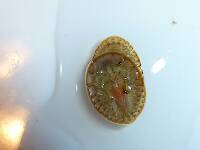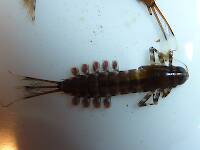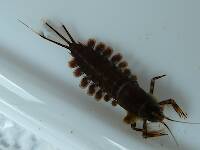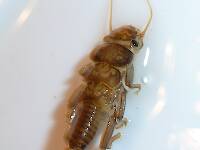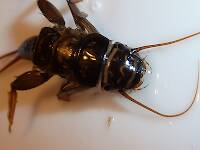
Hex Mayflies
Hexagenia limbata
The famous nocturnal Hex hatch of the Midwest (and a few other lucky locations) stirs to the surface mythically large brown trout that only touch streamers for the rest of the year.
Featured on the forum

Troutnut is a project started in 2003 by salmonid ecologist Jason "Troutnut" Neuswanger to help anglers and
fly tyers unabashedly embrace the entomological side of the sport. Learn more about Troutnut or
support the project for an enhanced experience here.
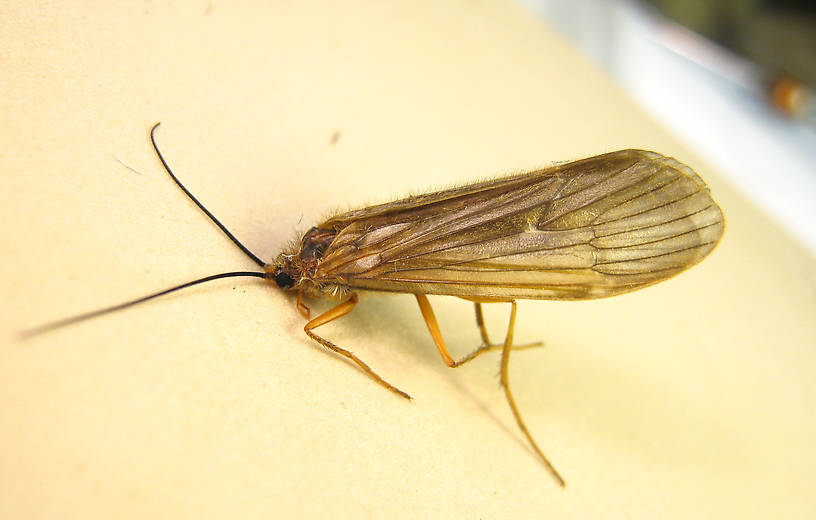
This specimen is 26 mm.
- Entoman
- Entoman
Entoman on Sep 29, 2013September 29th, 2013, 1:45 pm EDT
These two species are very difficult to tell apart. Because of the fuscated wing veining and black antennae, I'm leaning towards gilvipes, but it is my understanding that these characters are not very dependable. Regardless, both are the October caddis of western lore and can provide awesome dry fly fishing if the angler is lucky enough to hit it right.
There is some debate over which flies work better, dries or nymphs. I come down on the side of dry flies. I have rarely found the pupa effective, and even when they are it's often a darker color than the conventional orange that works best. For years I struggled with this until learning that the pupa (more properly called pharates) usually crawl out on shore to ecclode in the darkness of night. Since they also start from their rock cabins in very shallow water to begin with - not much nymphing opportunity there... It is highly doubtful that trout have the opportunity to feed much on the pharates, let alone enough to become selective. It is my opinion that when the pupal imitations work well, it is because they are either taken for drowned adults or perhaps it's just an attractor response to what looks like a big chunk of protein. Big fish often lose their caution this time of year as fishing pressure abates and storing calories for the Winter becomes a prerequisite.
There is some debate over which flies work better, dries or nymphs. I come down on the side of dry flies. I have rarely found the pupa effective, and even when they are it's often a darker color than the conventional orange that works best. For years I struggled with this until learning that the pupa (more properly called pharates) usually crawl out on shore to ecclode in the darkness of night. Since they also start from their rock cabins in very shallow water to begin with - not much nymphing opportunity there... It is highly doubtful that trout have the opportunity to feed much on the pharates, let alone enough to become selective. It is my opinion that when the pupal imitations work well, it is because they are either taken for drowned adults or perhaps it's just an attractor response to what looks like a big chunk of protein. Big fish often lose their caution this time of year as fishing pressure abates and storing calories for the Winter becomes a prerequisite.
"It's not that I find fishing so important, it's just that I find all other endeavors of Man equally unimportant... And not nearly as much fun!" Robert Traver, Anatomy of a Fisherman
Creno on Sep 29, 2013September 29th, 2013, 2:40 pm EDT
if you have the specimen D.atripes has a 1-2-2 spur count and D. gilvipes has a 1-3-4 spur count.
Entoman on Sep 29, 2013September 29th, 2013, 2:49 pm EDT
Thanks, Dave. I'm on it. Will post a photo. Can you tell anything from the genital photos? The reason I ask is because if they need to be properly dissected, cleared, and mounted to be helpful, I won't bother with trying to photograph them from so many angles beyond the need to show the sex.
"It's not that I find fishing so important, it's just that I find all other endeavors of Man equally unimportant... And not nearly as much fun!" Robert Traver, Anatomy of a Fisherman
Creno on Sep 29, 2013September 29th, 2013, 7:08 pm EDT
I can tell it is a female from the genital photos but I can also see that from the palps for this genus. For this species you should be able to do it with just an in focus image of the mid/hind tibia. But, in general macro lens are not sufficient magnification for caddis adult species determinations. My scope starts at around 3x and goes up from there. I tend to work between 10 and 80x but I often switch to a compound scope for the smaller taxa. I have found it is easy to make determinations when you can see the parts clearly :-)
But there is no reason not to take the genital pics (other than time I guess) as one often can see one small part in a pic that can determine species, especially for males. "Dissection" and clearing is not difficult - just remove abdomen from close to the thorax and place in 10% room temperature KOH for a day or so. Fresh material clears pretty fast, often in just a couple hours. Then use a small syringe (like a diabetic uses) to gently blow the remaining dissolved tissue from the abdomen and you should be able to see most everything ya need. There are alot of other methods but that one is simple, fairly safe, and works fine. They don't need to be mounted as the abdomen probably should be preserved in liguid. Depending on size and what I want to see I look at them on water, ETOH, or glycerin. and then store in ETOH if in a vial, or in glycerin in a microvial if the rest of the adult is on a pin.
But there is no reason not to take the genital pics (other than time I guess) as one often can see one small part in a pic that can determine species, especially for males. "Dissection" and clearing is not difficult - just remove abdomen from close to the thorax and place in 10% room temperature KOH for a day or so. Fresh material clears pretty fast, often in just a couple hours. Then use a small syringe (like a diabetic uses) to gently blow the remaining dissolved tissue from the abdomen and you should be able to see most everything ya need. There are alot of other methods but that one is simple, fairly safe, and works fine. They don't need to be mounted as the abdomen probably should be preserved in liguid. Depending on size and what I want to see I look at them on water, ETOH, or glycerin. and then store in ETOH if in a vial, or in glycerin in a microvial if the rest of the adult is on a pin.
Entoman on Sep 29, 2013September 29th, 2013, 7:13 pm EDT
Included with the specimen photos is a new one of a middle tibia. This gal's spur count is indeed 1-2-2. There is no evidence of preapical spurs on the middle or hind legs. I have moved the specimen to atripes so we now have some photos of this species in the encyclopedia. Thanks very much for the help, Dave!
"It's not that I find fishing so important, it's just that I find all other endeavors of Man equally unimportant... And not nearly as much fun!" Robert Traver, Anatomy of a Fisherman
Oldredbarn on Oct 3, 2013October 3rd, 2013, 10:29 am EDT
Kurt...Nice pic of this fly on Blue Ribbon Flies latest newsletter.
Spence
Spence
"Even when my best efforts fail it's a satisfying challenge, and that, after all, is the essence of fly fishing." -Chauncy Lively
"Envy not the man who lives beside the river, but the man the river flows through." Joseph T Heywood
"Envy not the man who lives beside the river, but the man the river flows through." Joseph T Heywood
Entoman on Oct 3, 2013October 3rd, 2013, 10:37 am EDT
Yeah, it's a lot better than mine.:) The cool thing about this critter is it's bulkiness. It's only a few mm longer than the big snow caddis I posted in the other thread but its body is at least 3 times the size by volume. Big chunk of food!
"It's not that I find fishing so important, it's just that I find all other endeavors of Man equally unimportant... And not nearly as much fun!" Robert Traver, Anatomy of a Fisherman
Clark2016
Posts: 1
Posts: 1
Clark2016 on Dec 19, 2016December 19th, 2016, 1:10 am EST
@ Entoman, I agree that October Caddis dries are more effective than pupa patterns .
Quick Reply
Related Discussions
Topic
Replies
Last Reply
8
Jun 5, 2007
by Dinerobyn
by Dinerobyn
Re: Identification of a possible Cordulegaster Dragonfly Nymph
In Cordulegaster Dragonfly Nymph by IanB
In Cordulegaster Dragonfly Nymph by IanB
6
Feb 10, 2017
by Taxon
by Taxon





